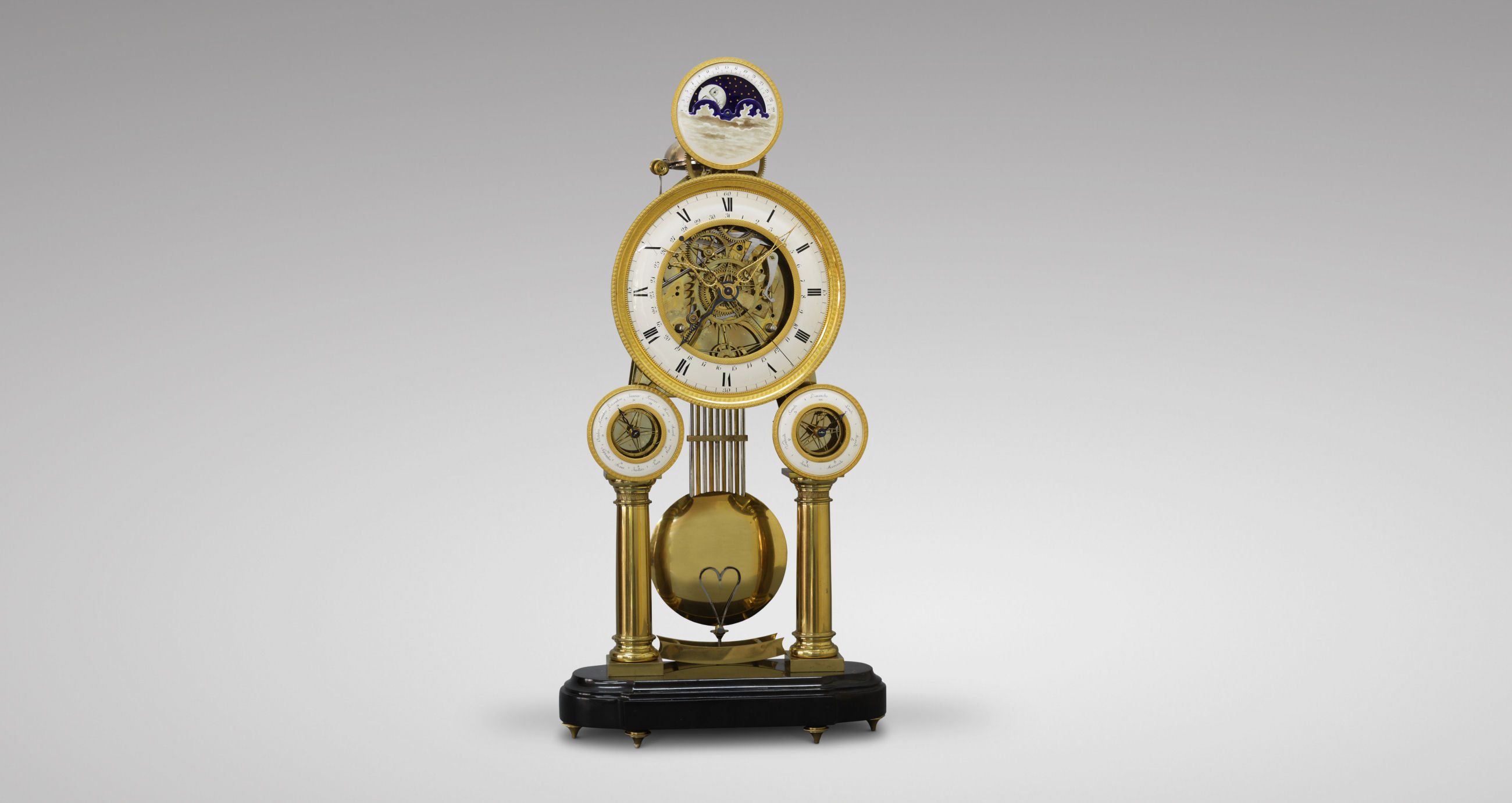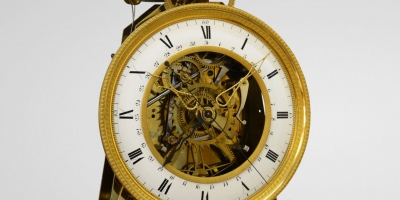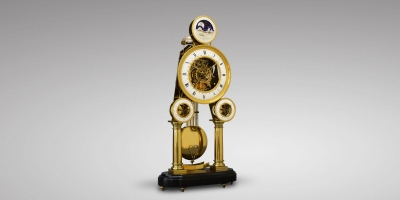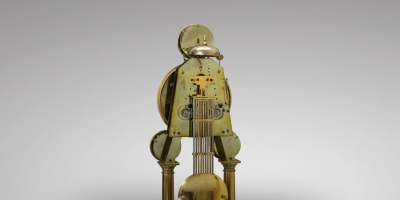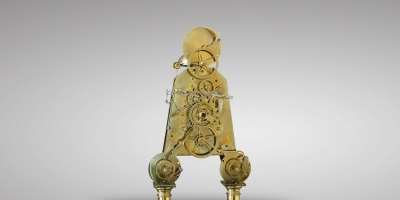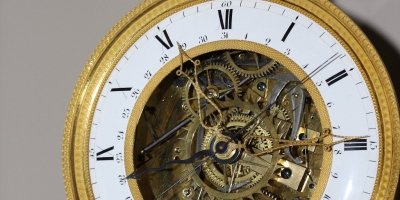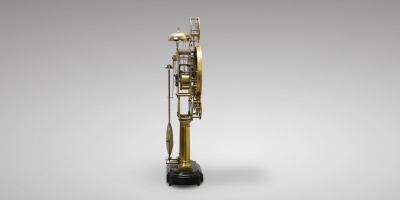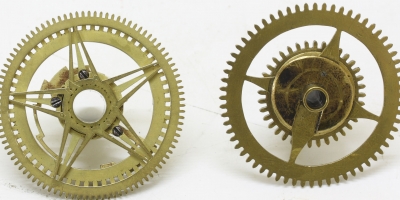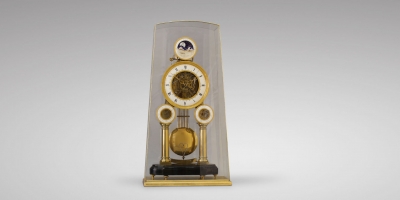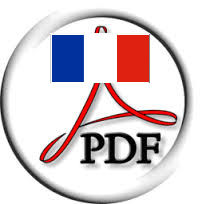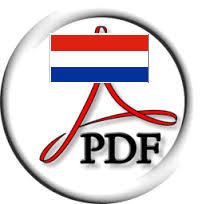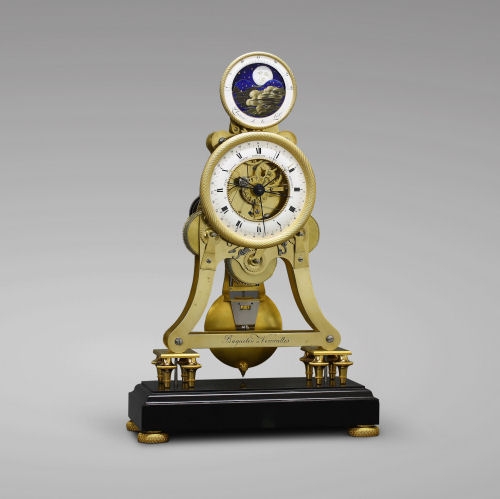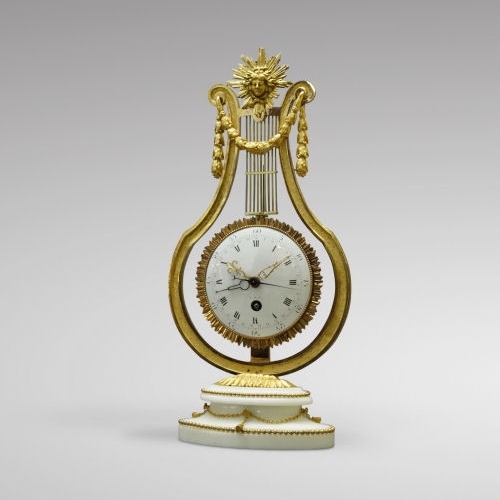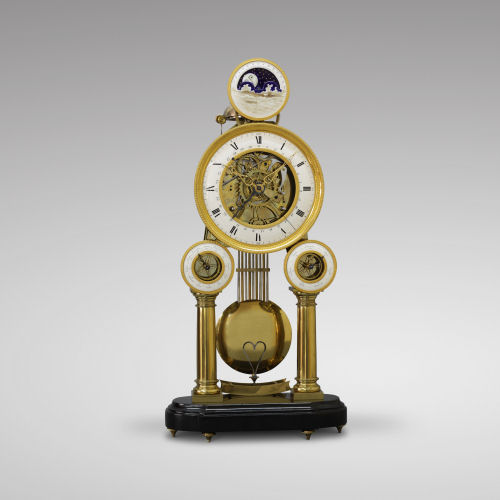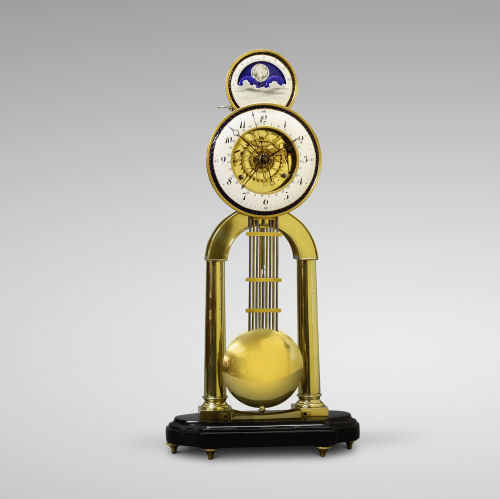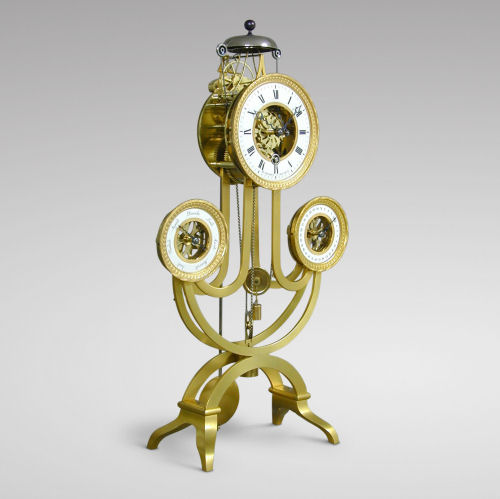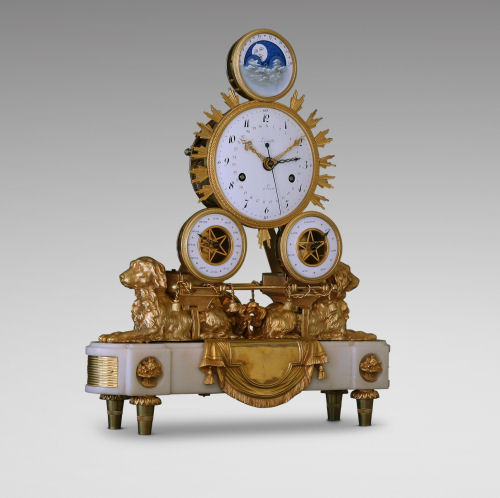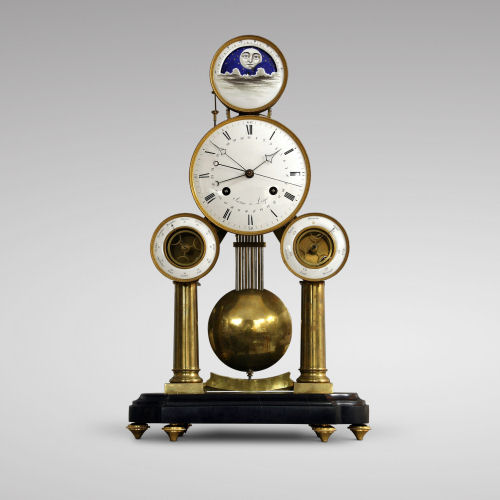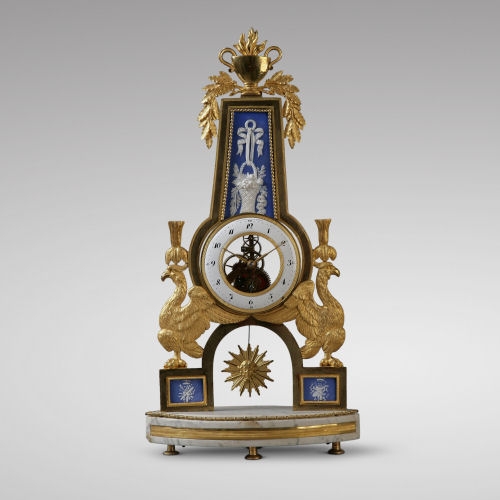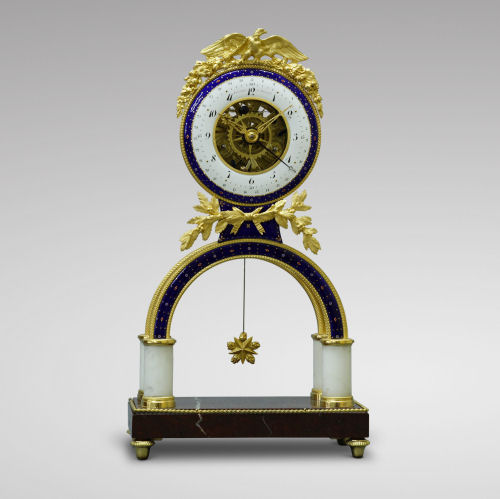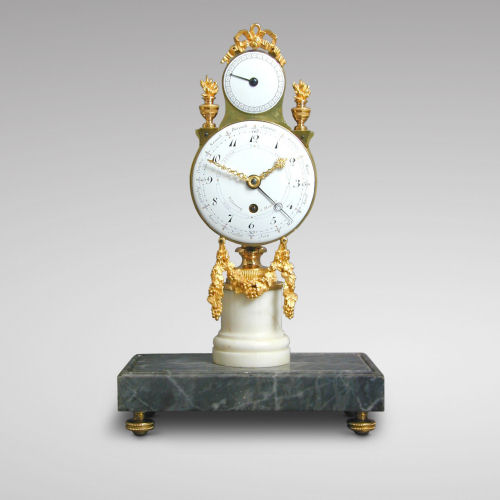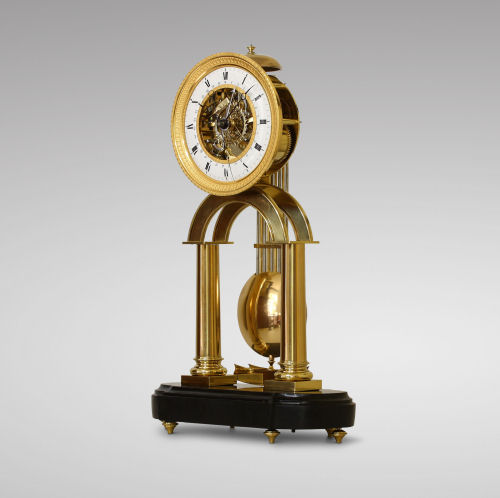Multi-dial brass, ormolu and black marble quarter-striking skeleton clock by Hubert Sarton circa 1810. Large diameter white enamel ring dial with concentric inner date ring framed within a foliate cast and beaded bezel, allowing for a good view of the front-mounted strike mechanism. Roman numerals with Arabic fifteen-minute markers, finely cut and engraved gilt-brass minutes and hour hands. Very fine center-sweeping seconds steel hand, three snake-shape steel calendar hands. Subsidiary calendar rings below for days of week with their deities and months with their number of days, lunar dial above with phase and age of the moon, the movement with trapeze-shape plates joined by two back-pinned pillars, twin barrels with 60-pin wheel escapement inside. Unique 2-rack strike mechanism on two bells mounted above, and striking the quarters in the Dutch fashion in a very unusual way: the count of hours on the large bell, one strike for the first quarter on the large bell, the count of hours ahead on the small bell for the half-hour, and three strikes on the small bell for the third quarter. Gridiron pendulum steel-suspended from a pivoted knife-edge block, the whole raised on struts above two pillars on a black marble D-ended plinth with ormolu feet. On the backplate, it is to be noted the very unusual rear-mounted steel click wheels, and the crossing-out of the two calendar wheels and all their transmission wheels are identical. Although this clock bears all the hallmarks of Hubert Sarton's Workshop, it seems to be the only one of this type ever produced.
Dimensions
Height: 24 " (61cm)
HUBERT SARTON (1748-1828)
Horologist to the court of princes
Hubert SARTON (1748-1828) lived during a momentous period in history. A product of the Enlightenment, he was also a precursor of the industrial age. Furthermore he was fortunate enough to grow up and live in Liège, which at the time was one of the most dynamic artisan and industrial centres in Europe. Very little has been written about him, yet his contribution to the art of horology is of great importance. He began learning the trade working for his uncle Dieudonné Sarton in 1762, where he demonstrated a remarkable talent for the mechanical sciences. After completing a four-year apprenticeship in Paris at the workshop of Pierre Leroy, eldest son of Julien and brother of Jean-Baptiste Leroy, he returned to Liège in 1772 as Master Clockmaker. Soon after he was appointed ‘Court Clockmaker’ to Duke Charles Alexander of Lorraine, Governor General of Austrian Netherlands, then, as ‘First Mechanic’ to Prince Bishop François-Charles de Velbrück, he enjoyed the benefits of a privileged position which extended his reputation well beyond the Principality of Liège. He also played a civic role being appointed Commissioner and Treasurer of the city of Liège in 1783. In a report published in 1789, the workshop of Hubert Sarton is described in terms that reflect the diversity and quality of his work, as well as his concern for innovation: “At HUBERT SARTON in Liège and Spa, one finds a most comprehensive assortment of clocks and watches, in the latest styles, like gold and silver watches of all kinds […]. One also finds a beautiful assortment of clocks from the most simple to the most complex.” Eleven years later, the French Revolutionary troops stormed Liège putting an end to Austrian rule. It is hard to ascertain exactly what consequences this historic event had on Hubert Sarton’s career. It appears from that time forward he concentrated on the production of skeleton clocks in a variety of models. The number of clocks produced suggests that Sarton certainly managed a large workshop with numerous employees – although no documentation has survived to either confirm or contradict this. Famous for inventing the automatic watch based on a rotor principle, for which he filed a patent at the French Academy of Sciences in 1778, Hubert Sarton created a variety of timepieces throughout his career – Louis XV cartels, Louis XVI mantle clocks, lyre mantle clocks, pendules de compagnie (company clock or waiting-room clock) skeleton clocks and regulators – all equally remarkable for their extraordinary quality and diversity. At once a devoted horologist, mechanic and inventor, Hubert Sarton was one of the major figures of horology in late eighteenth-century Liège. An enlightened man of his time, keen on progress and innovation, his considerable career unfolds as a long series of developments. Having successfully advanced all branches of his trade, this able mechanic dedicated to the art of horology became a master of his art, as witnessed in the exceptional quality and great refinement of his production.
Bibliography
L'Horlogerie et ses Artistes au Pays de Liége, Florent Pholien 1933; L'Age d'Or de l'Horlogerie Liégeoise, Ann Chevalier et André Thiry 2003; Les pendules d'Hubert Sarton, 1748-1828, Horloger-Mécanicien, Inventeur, mémoire présenté en 2009 à la Chambre Nationale des Experts Spécialisés en Meubles, Estampes, Livres, Objets d'Art et de Collection, Paris, Jacques Nève 2009.
Musea
Ansembourg Museum, Liège; Curtius Museum, Liège; François Duesberg Museum, Mons; Jehay Castle Museum, Jehay; "M" Museum, Leuven; Royal Art and History Museums, Brussels; Nederlands Goud, Zilver en Klokkenmuseum, Schoonhoven (NL); Museum Speelklok tot Pierment in Utrecht (NL); Musée des Arts et Métiers, Paris; Patek Philippe Museum, Geneva; Museum der Stadt, Vienna.
Price
On request
